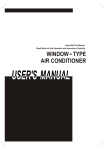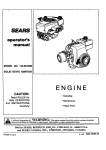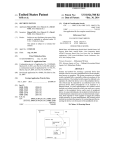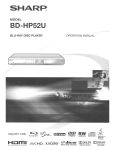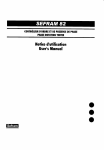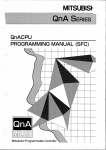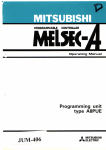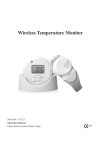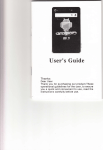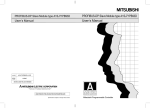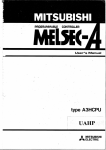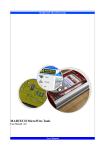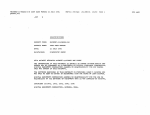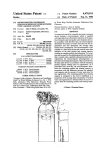Download A2A(S1),A3ACPU - User`s Manual (Supplement)
Transcript
REVISIONS The manual number is given on the bottom left of the back cover. Print Date Aug., 1992 . *Manual Number IB (NA) 66395-A Revision First edition INTRODUCTION Thank you for choosing the Mitsubishi MELSEC-A Series of General Purpose Programmable Controllers. Please read this manual carefully so that the equipment is used to its optimum. A oopy of this manual should be forwarded to the end User. 1 * ,f i CONTENTS . 1 GENERAL DESCRIPTION 1 .1 1.2 ....................................................................................................................... 1 Features .......................................................................................................................................... Use with Related Manuals ........................................................................................................... . ........................................ 3. CPU MODULE PERFORMANCE SPECIFICATIONS ........................................................................... 2 COMPATIBLE PERIPHERAL DEVICES AND SOFTWARE PACKAGES . 4 USER MEMORY WHEN EXECUTING AN SFC PROGRAM 4.1 4.2 4.3 4.4 . 5.1 5.2 5.3 5.4 5.5 5.6 - .................................................................................................. . . . 4 6 7 10 11-13 ....................................................... 14. 15 ErrorCodes .................................................................................................................................. Error LED Indicator Priority Setting .......................................................................................... 7 SFC PROGRAM PROCESSING TIME 7.1 7.2 3 To Execute an SFC Program by Continuation Restart.......................................................... 1 1 Instructions and Devices Usable as Operating Outputs and Transition Conditions ......... 1 1 Microcomputer Program Area of an AnACPU-F ..................................................................... 12 Precautions when Reading/Writing Program a Using Computer a Link .............................. 12 Data Stored to the Status Latch Step Number Storage Register (M9055)......................... 12 Single Start of an Inactive Block ............................................................................................... 13 6 ERROR CODES WHEN EXECUTING AN SFC PROGRAM 6.1 6.2 2 4-10 Memory Area Allocations for Memory Cassette Users ............................................................ SFC Program Work Area and Step Trace Data Storage Area ................................................ How to Calculate the Area Capacity Used as an SFC Program Work Area ......................... Functions Using an Extension File Register and Area Occupation Timing ........................ 5 PROGRAMMING PRECAUTIONS .- . ......................................................... 1 1 ........................................................................................... 16. 17 How to Calculate the Time to Process an SFC Program ...................................................... SFC System Processing Time ................................................................................................... I -~ ................. 14 15 16 17 .. 1. GENERAL DESCRIPTION 1. MELSEC-A GENERAL DESCRIPTION This manual explains theCPU performance specifications, necessary peripheraldevices,andprogrammingprecautions to takewhenoperatingan A2ACPU-F, A2ACPU-SI-F, or A3ACPU-F PC (all hereafter called an AnACPU-F) using SFC language. With an AnACPU-F, SFC processing time is considerably faster than with an AnNCPU-F (AlSCPU, AOJ2HCPU, and A2CCPU are included). The AnACPU has been designed to increase the ladder processing speed. However, theSFC processing timeis longer than the processing time required for a ladder processing only. 1.1 Features (1) The SFC system processing time has been shortened When operating an SFC program, system p~ocebting time is necessary as an overhead. However, this time was reduced. Therefore, as compared with an AnACPU-F, the total scan time has been reduced. for aninactiveblock has beenadded (2)Ablocksinglestartfunctions A function that singly starts an inactive block by using either a sequence program or a peripheral device has been added. This makes both partial testing of equipment and debugging of SFC programs easier. 1.2 Use withRelatedManuals Thismanualgivestheprecautions to take andthespecifications of the MELSAP-II function(SFC) which is necessaryto operate an AnACPU-Fusing SFC language. When consulting the relatedmanuals given below, read the indicated sections as if they were contents of this manual. Related manuals: (1) MELSAP-II Programming Manual (IB(NA)66361) 0 Applicable CPU (see Section 2.1) 0 Configuration of the user memory area (see Section 2.2) 0 List of devices (see Section 3.2) SFC program processing time (see Section 3.3) Instructions used for operation output/transition conditions (see Sections 4.3 and 4.6) 0 List of error codes (see Section 8) (2) SWOIX-SAP2E (MELSAP-II) Operating Manual (IB(NA)66313) Applicable CPU (see Section 2.1) 0 Inactive block single start (newly-added function) (3) SWOIX-GPPAE GPP Function Operating Manual (IB(NA)66314) 0 Parameter memory capacity setting (see Section 7.2) Precautions to take when setting the microcomputer program capacity for an AnACPU (newly-added function) (4) A2A(SI)/A3ACPU User’s Manual (Control Functions) (IB(NA)66256) CPU module performance specifications (see Section 3.1) User memory allocation (see Section 5.1.2) Changing LED display priorities (see Section 3.16) ( 5 ) TheUser’sManual of eachspecialmodulethatcanread/writeasequence program Microcomputer program read/write suitability (seethe sectionin each particular manual that explains the commands) -1- , - n 4 :3 2. COMPATIBLE PERIPHERAL DEVICES AND SOFTWARS,PACKAGES - MElsKGA 2. COMPATIBLE PERIPHERALDEVICESAND SOFlWARE PACKAGES Tabie 2.1 showstheperipheraldevicesthat can and cannot be used for creating and debugging SFC programs when operating an AnACPU-F using the SFC language during monitoring, as well as the software packages for the GPP and SFC functions. Table 2.1 Comblnations of Compatible Perlpheral Devices and Software Packages Poripheral Devices '1 A7PHPE PC/AT or compatible GPP Function Sottwaro Packages '1 SWORX-GPPAE ' 2 SWOIX-GPPAE POINTS YELSAP-I! (SFQ Function sottwm '1 SWORX-SAPPE SWOIX-SAP2E, Version B or earlier SWOIX-SAPPE. Version C or later Combinable OK NG OK I (1) *I : Available as of July, 1992. '2: There areno restrictions on which SWOIX-GPPAE GPP function software package can be combined with the MELSAP-II(SFC) function software package SWOIX-SAP2E. (2) TheSW4GP-GPPAGPPfunctionsoftwarepackageforan A6GPP/MPHP. is version E or later. If the version is E or later, there is an additional function about microcomputer program capacity setting in the memory capacity setting option of parameter setting for an AnA-F. SFC programs cannot be created and displayed. Memorycontents canbeconfirmedandchanged.Microcomputerprograms(SFC programs) can be read/written from/to the CPU and a floppy disk. -2- 3. CPU MODULE PERFORMANCE SPECIFICATIONS This seetion indicates how the performance specifications of an AnACPU-F differ from those of an-AnACPU. Any specifications not given in this section are the same for both an AnACPUF and an AnACPU. -The A2A(Sl)CA3,ACPUUser's Manual (Control Function) gives details. Items Available memory ABAIAmCPU-S 1-F A3NMCA-0 *1 ABACPU-F A3NMCA-0 '1 A3NMCA-56 Sequence program A3NMCA-56 A3AMCA-96 Sequence program microcomputer program 2 = max. 14 Ksteps (28 Kbytes) microcomputer program 2 = max. 30 Ksteps (60 Kbytes) 1 cassette + Main program capacity Microcomputer program = max. 13 Ksteps (26 Kbytes) can be set. Sub-program capacity No function. 1 + Microcomputer program = max. 29 Ksteps (58 Kbytes) can be set. Sequence program = max. 30 Ksteps can be set. (Microcomputer programs cannot be set.) *1: Since work areasfor an SFC program cannot be allocatedin an A3MCA-0 or A3NMCA-0, an A3MCA-0 and A3NMCA-0 cannot be utilized. *2: Since the microcomputer program area can only be used for storingSFC programs, the microcomputer program area cannot be used for storing microcomputer programs created bya user. I n addition,,themlcmcomputerprogramareacannotbeusedasan additional area for ufility software packagesfor the MELSEC-A series. r ' w -3- 4. USER MEMORY WHEN EXECUTING AN SFC PROGRAM This section explains the relationship between user memory areas in SFC an program work area andmemory cassettes needed to execute SFC programs. 4.1 Memory Area Allocations for Memory Cassette Users Table 4.1 showsthe memory area allocations for memory cassette users when doing parameter setting. Table 4.1 Memory Area Allocatlons for Memory Cassette Users ROM me6ory area Unusable Parameter area T/C set value area (main program use) sequence puter area T/C set value area (sub-program use) +5 RAM mc3n area Sub-sequence program area System area for sub-sequence execution Extension comment area 1 Block No. 8 Extension file register 1 Block No. 1 I File register area Comment area Extension I Block No. 0 ... 3 Kbytes (indespensible) ... 1 Kbytes (indispensable) ... Set parameters in the range of 1 to 30 Ksteps (2 to 60 Kbytes). ... Set parameters in the range of 2 to 58 Kbytes (However, it can be set within 60 Kbytes with a sequence area.) ... 1 Kbyte (When a sub-program is set) ... Set parameters in the range of 0 to 30 Ksteps (0 to 60 Kbytes). (Settings can only be done with an A3A-F.) ... 5 Kbytes (When a sub-program is set) ... When a capacity is set using a parameter 1 ... One block = 16 Kbytes *2/+3 max. 8 blocks Set parameters in the range of 0 to 16 Kbytes. ... Set parameters in the range of 0 and 2 to 64 Kbytes. 1 ... 1 block = 16 Kbytes -4- With an A2A(S1) : 0 = 2 8 With an A3A :0 = 4 8 4. USER MEMORY WHEN EXECUTING AN SFC PROGRAM Kbyt9s)wkensetting an No. 10 of extension comment. Extension comments are stored after block ,the exteffsioriYite register. If an extenbion comment isstored in block No. 10, area 4) is the available area for calculating the number of blocks of extension file registers of block Nos. 1 408. If the block area after No. 10 is smaller than the set extension comment CPU write capacity, the memory areawillbeinsufficient.Therefore, operations cannot be done. *2: Calculate the available number of blocks of anextension file register (block Nos. I. to 8 ) 1) - 2) - 3) - (4)) - 5) K bytes= nl 0 During RAM operation 16 1) - 3) - (4)) - 5 ) Kbytes= n2 0 During ROM operation 16 The integer value of n l and n2 is the available number of blocks in block numbers 1 to 8 . *3: Designate an extension file register b,bck number to the data storage area trace and numbers Qf abampling trace and a status latch when a sampling status Iatdh are being executed online. '4: This area ?An be stored to the ROM. When this area id"stored to the ROM, areas 3) and 4) are condensed. And then, the site of an 'available area for calculating the numberof available blocks of extension file registers of block numbers 1 to 8 increases. *5:The following table gives the capacitiesof each-memory cassette model. *1: If the.'&tension coinmemcapacify Y (f)-Zj-3)-5) i I Marllr9ry Cassette Node1 Names Memory Carsetts Capacities Capacities in Table 4.1 (1) - AB(N)MCA-O A3(N)MCA-2 A3( N)MCA-4 16 Kbytes 16 Kbytes 32 Kbytes 32 Kbytes 64 Kbytes A3MCA.12 64 Kbyles 96 Kbytes A3NMCA-16 A3MCA- 18 128 Kbytes 144 Kbytes 96 Kbytes A3NMCA-24 192 Kbytes 144 Kbytes 144 Kbytes A3NMCA-40 320 Kbytes 144 Kbytes A3N MCA-56 448 Kbytes 144 Kbytes A3NMCA-96 768 Kbytes 144 Kbytes A3( N)MCA-8 1(only for an A3A(-F)) -5- 96 Kbytes I 4. USER MEMORY WHEN EXECUTMG AN SFC PRO6RAM 4.2 #-. SFC Program Work Area and Step Trace Data Storage Area (1) SFC program work area When executing an SFC program, the system uses 4 Kbytes of the user memory area of a memory cassette as an SFC program work area. In addition, the system uses amax. 12 Kbytes asthe step trace datastorage area. If the user memory area of a memory cassette does not have an available capacity of 4 Kbytes or more, SFC programs cannot be executed. Whenexecutingasteptrace,2 to 12 Kbytes of availablearea are necessary in addition to the 4 Kbytes for the work area. (2) Howtocalculatetheavailablecapacity of a memory cassette’suser memory area Theavailablecapacity is calculated by subtracting the parameter-set memory capacity from the total area that can be parameter-set. Max. 144 Kbytes (Area indicated in Table 4.1 (1)) Samplecalculation: The following shows asamplecalculation of an availablecapacitywhenthefollowingconditions have been satisfied. Memory cassette .....A3NMCA-24 Main program (microcomputer program included).....10 Ksteps File register.....4 Kpoints Comment .....40 Kbytes Memory space capacity = 144K-(3K+l K+20K+8K+40K)=72Kbytes 1) 2) 3) 4) 5) 6) 1): Capacity of an A3NMCA-24 that can be parameter-set (Area indicated in Table 4.1(1)) 2): Parameter storage area 3): T/C set value area 4): Main program (1 step 2 bytes = 10 Ksteps x 2) 5 ) : File register (1 point 2 bytes = 4 Kpoints x 2) 6): Comment capacity The memory space capacity is calculated as 72 Kbytes. -6- 4. USER MEMORY WHEN EXECUTING AN SFC PROGRAM 4.3 -M€LSEGA How to Calculate the Area Capacky U W as m SFC Pmgram Wotlr Area A;' n L This section showshow to calculate thearea capacity of the memory cassette that is usedas an SFC programworkarea andwhether or not an SFC program can be executed. When an SFC progPam cannot be executed in the following explanation, it is necessary to changeeither(a)the memory cassette, or (b)thememory capacity parameter setting. The memory capacity set with a parameter in the following explanation is the sum of the memorycapaqity when a userset or changed the memory capacity set with parameters. The default value is 16 Kbytes. (1) If the memory cassette is one of the following: A3(N)MCA-2 A3(N)MCA-4 A3(N)MCA-8 A3MCA-12 (Area capacity of Table 4.1 (1 )) - (Memory capacity set with a parameter) = A A : 16 Kbytes or more canbe executed, and amax. 12 Kbytes step trace capacity can beoccupied. Since extension file register No. 1 is utilized as an SFC program work area, this cannot be utilize'd as an area for user data storage. : More than 4 Kbytes less than 15 Kbytes ......an SFC program can be executed. Step trace capacityS A - 4 Kbytes. : 4 Kbytes or less ......an SFC program cannot be executed., ......an SFC program -7- 1 c1 )r 4. USER MEMORY W H N EXECUTING AN SFC PROGRAM MLSEGA (2) If the memory cassette is the following: A3NMCA-16 (Area capacity of Table 4.1 (1)) - (Memory capacity set with a parameter) = A When an extension comment capacity is set, and A is minus (Area capacity of Table 4.1 (1)) (Memory capacity set with a parameter - extension comment capacity) = A : 16 Kbytes ......an SFC or more program can be executed, and a max. 12 Kbytes step trace capacity can beoccupied. Since extension file register No. 1 is utilized as an SFC program work area, this cannot beutilized as an area for user datastorage. : 15 Kbytes or less ......an SFC program can beexecuted, and a max. 12 Kbytes step trace capacity can be occupied. However, the work area is movedto extension file register No.10. Since extension file register No. 10 is utilized as an SFC program work area, this cannot be utilized as an area for userdata storage. B : 16 Kbytesor more ......an SFC program can be executed, and max. a 12 Kbytes step trace capacity can beoccupied. Since extension file register No. 1 is utilized as a SFC program work area, this cannot be utilized as an area for userdata storage. : More than 4 Kbytes and less than 15 Kbytes ......an SFC program can be executed. Step trace capacity I B - 4 Kbytes. : 4 Kbytes or less ......an SFC program cannot be executed. (3) If the memory cassette type is the following: A3NMCA-18 (Area capacity of Table 4.1 (1)) - (Memory capacity set with a parameter) = A A : 32 Kbytes or less ......an SFC program -.. can be executed and max. a 12 Kbytes step trace capacity can be occupied. Since extension file register No. 2 is utilized as an SFC program work area, this cannot be utilized as an area for userdata storage. : More than 4 Kbytes less than 15 Kbytes ......an SFC program can be executed. Step trace capacity I A - 4 Kbytes. : More than 16 Kbytes and less than 31 Kbytes ......an SFC program cannot be executed. However, an SFC program can be executed by parameter setting of a dummy capacity and setting the capacity of "A" at 15 Kbytes or less. : 4 Kbytes or less ......an SFC program cannot be executed. -8- 4. USER MEMORY WHEN EXECUTING AN SFC PROGRAM t (4) If the memory cassette is one of the following: A3NMCA-24 0 A3NMCA-40 A3NMCA-56 A3NMCA-96 (Area capacity of Table 4.1(1)) - (Memory capacity set with a parameter) =A When an extension comment capacity is set, and A is minus (Area capacity of Table 4.1 (1 )) (Memory capacity set with a parameter - extension comment capacity) 4 =& A : 32 Kbytes or more ., , ,..an SFC program be be canbe executed, and a max.12 Kbytes step trace capacity can be occupied. Since extension file register No. 2 is utilized as an SFC program work area, this cannot be utilizedas an area for user data storage. : 15 Kbytes or less ......an SFC program can be executed, and a max. 12 Kbytes step trace can capacity occupied. However, the work area is moved to extension file register No. 10. Since extension file register No. 10 is utilized as an SFC program work area, this cannot beutilized as an area for user datastorage. -6 : 32 Kbytes or lees ......an SFC program can be executed, and max. a 12 Kbytes step trace can capacity occupied. Since extension file register No. 2 is utilized as an SFC program work area, this cannot be utilizedas an area for user data storage. : More than 4 Kbytes and less than 15 Kbytes ......an SFC program can be executed. Step trace capacity s B - 4 Kbytes. : More than 16 Kbytes and less than 31 Kbytes ......an SFC program cannot be executed. However, an SFC program can be executed by parameter setting of a dummy capacity and setting the capacity of "A" at 15 Kbytes or less. : 4 Kbytes or less ......an SFC program cannot be executed. -9- q U .._, l a 4. USER MEMORY WHEN EXECUTINGAN SFC PROGRAM 4.4 Functions Using an Extension File Register MECSEGA and Area Occupatlon Tlmlng Table 4.3 shows the functions using an extension file register, area occupation timing, and area occupation priorities. Table 4.3 Functions Using an Extension File Register and Area Occupation Tlmlng Functions Uaing an Extension File Rogkter Area Occupation Timing Area Occupation Priority Extension comment When a parameter with which an extension comment capacity was set is written to a CPU 1 SFC work area When a parameter with which a microcomputer program capacity was set is written to a CPU 2 Ontine sampling trace Online status latch When tracenatch data storage register No. is set and i s written to a CPU 3 Extengion file register access instruction Access by a computer link When an instruction is executed or when a computer link is Presence or absence of the corresponding block numbers and access validity are checked at this time 4 *I :If the memory capacity of a parameter is changed after executing an S F C program, block No. 10 of an SFC program work area sometimes changes. Sections 4.1 and 4.2 give details about confirming the block number that is used as a work area. '2:If an SFC program is designated to the continuation start and a program is started when a parameter is first written to a CPU or when the memory capacity of a parameter is changed, SFC PARA.ERROR (error code 80 and detailed error code 804) occur. And then, an SFC program is started from the initial step of block 0. - 10- 5. PROGRAMMING PRECAUTIONS This section givss the precautions to take when programming to execute an SFC program on an AnA-F. 5.1 To Execute drvSf% Program by Cdntfnuatlon Restart (1) To execute an SFC program by contunuation restart on an AnA-F, special relay M9102 must be turned ON (contunuation restart) all the time an SFC program is being executed. If M9102 is .turned ON when an SFC program is restarted, after it is executed with M9t02 being turned OFF, the SFC PARA. ERROR (error code 80, detail error code 804) message is displayed. Then, an SFC program is started by initialstart (start with the initial step i n block 0). (2) When an SFC program is executed, the SFC processing time of the CPU varies according to the ON/OFF status changes of M9102. The list of processing times in Section 7.2 gives details. 5.2 instructions and Devices Usable as Operating Outputs and Transition Conditions (1) Instructions usable as operating outputs and (a) Common instructions except for the following are usable: CJ, SCJ, JMP, FEND, RET, IRET, MC, MCR,CHG, CHK, and labels Pn In (b) Dedicated instructions except for the following are usable: BREAK, CHK, and CHKEND (2) Instructions usable as transition conditions 0 Contact instructions: LD, LDI, AND, ANI, OR, OR1 Branch end instructions: ANB, ORB 0 Comparison operation instructions: LD(D)= , LD(D)> , LD(D)>= D)< LD( , LD(D)<= , AND(D)= , AND(D)> , AND(D)>= AND( D)c , AND(D)<= , OR(D)= ,OW)> , OR(D)>= OR(D)c , OR(D)<= , LD(D)o , AND(D)<> , OR(D)o (3) Devices usable with an SFC program Extension devices (M2048 to 8191, Dl024 to 6143, etc.) of an AnACPU can be utilized in the ladder circuits of operating outputs and transition conditions, and for SFC data registers when used with an SFC program. - 11 - m b'' + 'd 5. PROGRAMMING PRECAUTIONS - 5.3 “€CIA Microcomputer Program Area of an AnACPU-F Using a microcomputer program with an AnACPU-F The microcomputer program area of an AnACPU-F can be utilized for storing an SFC program. This area cannotbe utilizedfor storing a user’s microcomputer programs or as an additional areafor a utility software package for the MELSEC-A series. Precautions when writing a parameter to a CPU when the parameter has been set with a microcomputer program capacity If an attempt is made to write a parameter with which a microcomputer program capacity has been set to an AnACPU which does not have the -F code, a parameter error occurs which disables the CPU. Do not set a microcomputer program capacity with a parameter on a peripheral deviceexceptwhenan SFC programisexecutedwithan AnACPU-F. 5.4 Precautions when Readlng/Writing a Program Using a Computer Link If a microcomputer program (SFC program) of an AnACPU-F is read/written by using a computer link, the following module is unable to execute such a program: AD51 H intelligent communications module When a module which is capable of reading/writing a program is utilized, a microcomputerprogramcanberead/writtenbyusingacommand to read/write a microcomputer program. 56 Data Stored to the Status Latch Step Number Storage Register (M9055) Special register D9055 which is utilized to store a status latch execution step number when status latch is executed is utilized to store the SFC process execution block and step numbers when an SFC program is executed. 0 When status latch is executed: A status latch execution step number is stored. If an SFC program is executed after the execution of status latch, stored data will be overwritten. Therefore, data stored by the execution of status latch must be saved toany other register to avoid overwriting. When an SFC program is executed: The SFC process execution block and step numbers are stored. Execution block number (stored inBIN) Higher 8 bits Execution step number (stored in BIN) I I - 12- Lower 8 bits 5. PROGRAMMING PRECAUTIONS Start 5.6 Slngle lnactlveof an . 9'. Block i k"w&+xa 3 Starting a sub-block other than block 0 requires a sub-block start request issued by any other blodc in an SFC program. When an SFC program is executed in an AnACPU-F, any designated block can be started by turning ON the block activating bit of an inactive block by using a program or the test $unction, etc. of a peripheral device. (1) How to execute single start of a block Any of the fotkwing-rnethodscan beutilized for single startof an inactive block: Create a program which twns ON the block activating bitof a block when a condition Is established in a sequence program. Forcibly turn ON the block activating bitof a block by using the test function of a peripheral device. Forciblyturn ON theblockactivating computer link. bit of ablockbyusinga (2) Precautions when executing single start of a block The following precautions must be taken when single start is executed to a designated block: Each block activating bit needs to be set as a data register in each block. If the block activating bit of an actlve blockis turnedON by the single start function, the start request is ignored and that block continues execution of an SFC program. If a sub-block start is executed by an SFC program to a block which has been activated by the single start function, theEXE.ERROR SFC error occurs. To execute sub-block start by an SFC program, the block activating bit of a corresponding block needs to &e insluded as an interlock in the transition conditions for executing the sub-block start. Since the block activating bit is turned OFF by the system when the end of the corresponding block has been reached, the user does not need to turn OFF (RST) the bit. If a block activating bit which is ON is forcibly turned OFF by a sequence program or peripheral device, the end of the corresponding block will not be reached and the block remains active. In this case, the block activating bit which is includedas an interlock for executing a sub-block start by an SFC program is turned OFF, disabling the interlock function. An SFC EXE.ERROR error occurs since a block start requesthasbeenmade to an already-started block. - 13- 6. ERROR CODES WHEN EXECUTING AN SPC P R O G W 6. 6.1 U6LSEC-A ERROR CODES WHEN EXECUTING AN SFC PROGRAM Error Codes '1 Error Code. Table 6.1 lists themessages and codesof the errors thatcan be caused when executing an SFC program, and the corresponding CPU statuses. Table 6.1 Error Codes Detail Erro'i Codes Laddors SFC Cannot start the SFC program since the memory cassette is A3(N)MCA-O. 801 SFC PARA. ERROR 802 80 1 I CPU statuses A large enough work area for the SFC program cannot be assigned since the user's memory has free space of 4 Kbytes or less. stop Continue 803 804 The SFC program area in the memory cassette is memory-protected. Initial start 805 The memory capacity parameter was changed when continuation restart was designated (M9102:ON). The CPU was reset when continuation restart was designated (M9102:ON). The SFC program contains an instruction that cannot be decoded. SFC CODE ERROR 81 stop Stop SFC STEP OVER 82 stop Stop The number of simultaneous active steps of the SFC program exceeded the maximum ( 1 024). SFC EXE. ERROR 83 stop Stop A request was made to start an active block that was already started. '4 Continue /Stop Continue /Stop SFC OPE. ERROR 84 - 831 840 '3 After changing the memory capacity parameter, the SFC program capacity became greater than the microcomputer program capacity. '4 An arithmetic operation error occurred. The device range was exceeded when performing an operating output in the SFC program or computing transition conditions using the ladder diagram. *1 :Data registerD9008 stores an error code. '2:Data register D9091 stores a detail error code. *3:0 indicates the lowest digitof the detail error code (OPERATION ERROR) which occurred when executing the program. Example: When data or a constant in a designated device exceeded the allowable range. Executed Programs Error Codes Detail Error Codes When executing a main program 50 503 When executing an SFC program 84 843 '4: Determined by the error operation mode setting. The default is "continue". - 14- 6. ERROR CODES WHEN EXECUTING AN SFC PROGRAM 6.2 r5 Error LED lndlcator Prlorlfy -5ettfrg ._ This section describes (a) the causes and (b) the error indication priority. of the errors that IightMlash the LED, (1) Error causes that unconditionaUy light/flash the LED When causing an error that stops the CPU. (2) Error causes (a).whose priority to lighvflash the LED can bechanged, or (b) that canbe set to not to IlghVflash the LED The following error causes can be set in special registers 09038 and D9039 to change their priority or to disable light/flash of the LED. I Cause I NO. II ’ II 1 Error Causes InpuVOutput verification error, fuse blown %ecial-function module errof, )ink parameter error, 3 CHK instruction error 4 Annunciator (F) ON 5 LED instruction 6 7 , Battery error Clock data - 15- I A3A-F APA-F I I Outputs the c o r m message to the LED display module when an error occurs. Error LED lit. I l Error LED flashes. - Error LED lit. - n w 7. SFC PROGRAM PROCESSING TIME 7. MELSEGA SFCPROGRAMPROCESSINGTIME This section describes the time required to process a sequence program and an SFC program. 7.1 How to Calculate the Time to Process an SFC Program This section explains(a) how to calculate the time required to execute anSFC program, and (b) the scan time. time to processa Scan time = sequence program + timetoprocessan SFC program + END processing time 1) 2) 3) 1) Total processing timeof instructions used in the main (sub) sequence program. 2) Total of the time of instructions processed for operating output and transition conditions and of system processing. SFC program processing time Time of instructions processed for operating outputandtransitionconditions (a) Time of instructions processed for operating output and transition conditions Time of instructions processed for operating output and transition conditions =! 1 Time of instructions processed for operating output + Time of instructions processed for transition conditions Operating output instructions processing time Total processing time of instructions used for operating output of all executable (active) steps. If the transition conditions are satisfied, "total processing time x 2" will be applied. 0 Transition condition instructions processing time Total processing time of the instructions used for transition conditions included in all executable (active) steps. (b) System processing time Section 7.2 gives details about the system processing time and a calculation example. 3) END processing time (self-diagnosis, etc.) - 16- 7.2 SFC System Processlng Time This section explains the system processing time (when executing an SFC program) in comparison with the AnNCPU-F. Table 7.1 SFC System Processlng Tlme In the case of initial start h, SFC END processing ‘ k d SFC system processing time calculation example: Designate continuation restart (M9102: ON) Number of active blocks: 30 (Active blocks used for anSFC program) Number of inactive blocks: 70 (inactive blocks used for an SFC program) Number of available blocks: 50 (Blocks set bythe parameters that are not used foran SFC program) Number of active steps: 60 (Active steps in active blocks) 0 Transition condition included in active steps: 60 Transition condition satisfying steps: 10 (Active steps that satisfy transition conditions) SFC system processing time = 195 + (57x 30) + (14 x 70) + (4 x 50) + (49.5 x 60)+ (29.5 x 60)+ (17 x 10) = 7795 ps = 8 msec As indicated above, the SFC system processing time is8 msec. Under the same conditions, however, it is approx. 11 msec in the case of an A2ACPU-F; approx.44 msec in the case of an AnNCPU-F. The scan time consistsof the SFC system processing time, the time required to process the transition conditions included in the SFC active steps, and the CPU END processing time. i - 17- IMPORTANTI C (1) Design the configuration of a system to provide an external protective or safety inter locking circuit for the PCs. (2) The components on the printed circuit boards will be damaged by static electricity, so avoid handling them directly. If it is necessary to handle them take the following precautions. (a) Ground human body and work bench. I I (b) Do not touch the conductive areas of the printed circuit board and parts with and non-grounded tools etc. its electrical I Under no circumstances will Mitsubishi Electric be liable or responsible forany consequential damage that may arise as a result of the installation or use of this equipment. 1 All examples and diagrams shown in this manual are intended only as an aid to understanding the text, not to guarantee operation. Mitsubishi Electric will accept no responsibility for actual use of the product based on these illustrative examples. Owing to the very great variety in possible applications of this equipment, you must satisfy yourself as to its suitability for your specific application. I I A MlTSUBlSHl ELECTRIC CORPORATION When exported from Japan, this manual does not require application to the Ministry of International Trade and Industry for sewice transaction permission IB (NA) 66395-A (9208) MEE Printed Japan Specifications in subject change towithout notice ‘I ‘I, Jumber Stored Data Name Explanation When VO module data is different entered those from at power-on have 16 points) are entered been detected, the UO module numbers (in units of in bit (Preset pattern. I/O parameter has numbers module when setting been 'D9116 'D9117 performed:) lnar 4 0 110 ''D9123 D9124 ~9116 Bit Pattern in modules of 16 pointsofverify error modules module 1 5 1 4 1 3 1 2 1 1 1 0 9 8 7 6 5 4 3 2 1 w117 W123 h n d k a t e a VO unit verify error. (Ifnormalstatusisrestored,clearisnotperformed.Therefore, required to performclearby user program.) I it is 09124. (ForABNCPU, it can executed, 1 is subtracted from the contents of detectionbeperformedbyuseof INDICATOR RESET switchonfront face of CPU Annunciator Annuhciator detection I 0 I I D9125 D9126 D9127 When one ofFO t o 255 is turned on by ( O U T j or which has turned on, i s entered into D9125 to D9132 il code. F number, which has been turned off by is erased from D9125 to D9132, and the contents of data registers succeeding the data register, where theerased F number was stored,are shifted to the preceding data registers. By executing1 instruction, the contents of 09125 to D9132 are shifted upward by one. (For A3NCPU, it can be performed by use oi INDICATOR RKSET switch on frontof CPU unit.) When there are 8 annunciator detections, the 9th one is not stored into D9125 to 9132 evenifdetected. IRSTl, SETSETSETRETSETSETSETSETSETSETSET F50F25F1QF25 F15 F70F65F38 FllOF151F210 LEDR . n4nn-qn-n-n- D9128 Annunciator detection number Annunciator detection number ~ D9009 D9124 D9129 W125 09126 D9127 D9130 D9128 D9129 D9131 D9130 D9131 D9132 D9132 I I I Special Register List APP-13 IB IhAI 66161-A (1) All specialregister-data is cleared by anyofthe data is power-off, latch clear and reset operations. The retained when the RUNISTOP switch is sett o STOP. (2) For the above speoial registers with numbers marked '1, the contents of register are not cleared if normal status is restored. Therefore, t o clear the contents, use the following method: Clear execution 1) Method by F L [ R S T D9005d user program. Insert the circuit shown at right into the program and turn on the clear execution command contact t o clear the contents of register. 2) Method by peripheral equipment. Set the register t o ' 0 " by changing the present value by the test function of peripheral equipment or set t o "0" by forced reset. For the operation procedure, refer to the manual of each peripheral equipment. 3) By moving the RESET key switch at the CPU front t o t h eRESET position, the special register is set to '0". (3) Data is written to the special registers marked *2 b y the sequence program. I! i # APP-14 4 IB INA) €6161-A d i APPENDIX 4 Dimensions 4.1 CPU module 11 , 4.2 (0.17) , , 3(0.12) I 1- Printedcircuit board 1.2 (0.17) - 121(4.76) 79.5 (3.13) -1 J Unit: mm (inch) APP-15 IB INAl €6161-A 4.2 Power supply modules (1) Type A61P,A62P,A63P,A65P 1 power supply moduies A65P 0 POMR @ FUSE c 4 INPUT .C1001200" 3 3 . SHORT AC,OO" SHORT l C 2 D G V LO FG 4.2 10.17) i OUTPUT \ 55 (2.17) (forterminalscrew) Unit: mm (inch) APP-16 . ~ . IS (NAI 66161-A t 6 L. (2) Type A66P powersupply 1 4.2(0.17) module ,+ M3 (0.12) X 0.5 (0.02)X 6 (0.24) (Terminal screw) Printed circuit board ... J - II -. 6(0.24) 106(4.17) 121 (4.76) Unit: m m (inch) 4.3 Basic base units (1) Type A326 base unit 10-M4 screws (Metric screws) dia. installation holes Hand module installation)\ (for hold 4-6mm (0.24 inches) /(M5 mounting screw) i i 227 (8.94) (1.14) i Unit:mm(inch) (2)Type A35B base unit Hand hold 7 4-6mm (0.24 inches) dia. installation holes '(M5 mounting screw) 16-M4 screws (Metric screws) (for module installation) \ \ \ E 0 Base cover / t 1 362 (14.25) 382 ( 15.04) 1291 (1.14) Unit:mm(inch) APP- 18 IB iNAi 66161-A ? 0 I APPENDICES (3)Type A38B base unit 22-M4 screws Metric screws 4-6mm(0.24inches) dia. installation holes Unit: mrn (inch) APP- 19 IB (NAI 66161-A 4.4 Extensionbaseunits (1) Type A65B base unit 12-4Mscrews(Metricscrews) (for module installation)\ (M5 mounting screw) 4-6mm(0.24inches) dia.installationholes Base cover Hand hold 7 (2) Type A68B base unit 18-4Mscrews(Metricscrews) (for module installation)\ Base cover d ddddddddB Hand hold 7 j 4-6mm(0.24inches) dia.installationholes /(M5 mounting screw) 0 0 Lci (v I_ 1291 (1.14) 3 ' APP-20 Unit: mm (inch) IB INA) 66161-A # 1. tc d 10-M4 screws (Metric screws) /m-rJnting screw) dia. installation holes IO1 F I c L 129 277 (10.91) 297 (1 1.70) - (1.14) Unit:mrn(inch) (4) Type A58B base unit 4-6mm (0.24 inches) 16-M4 screws (Metric screws) dia. installation holes /(M5 mounting screw) (for module installation)\ 4 Base cover 4 + + + + 4 \ + / / t - Hand hold I I 01 391 (15.39) 411 (16.18) - =I 1 (1.14) 0 Unit:mrn(inch) APP-21 IB (NA) 66161-A . c 4 PULL L i I I Unit: rnrn (inch) APP-22 r 4 IB iNAl 66161-A 4



































